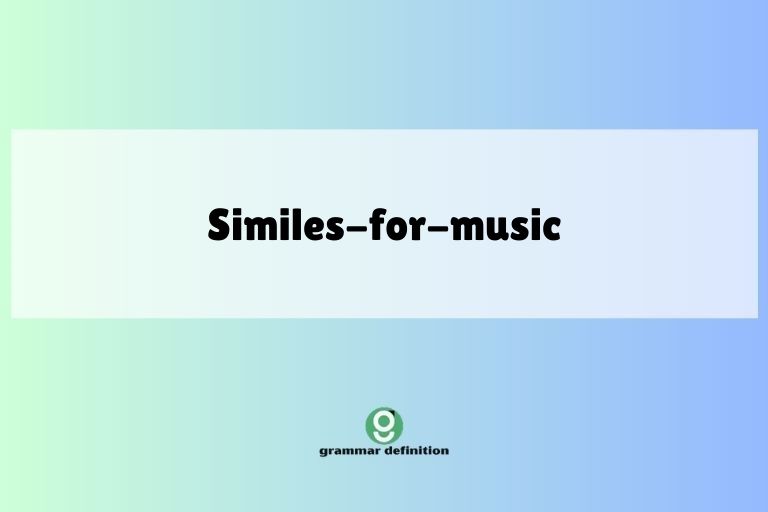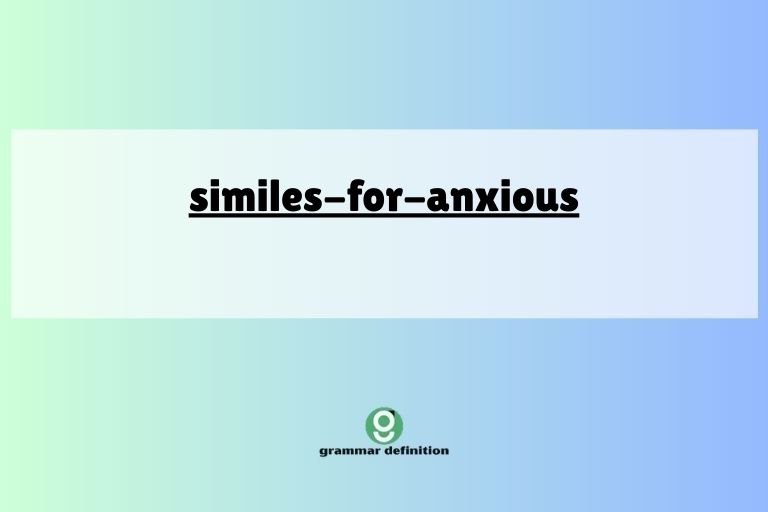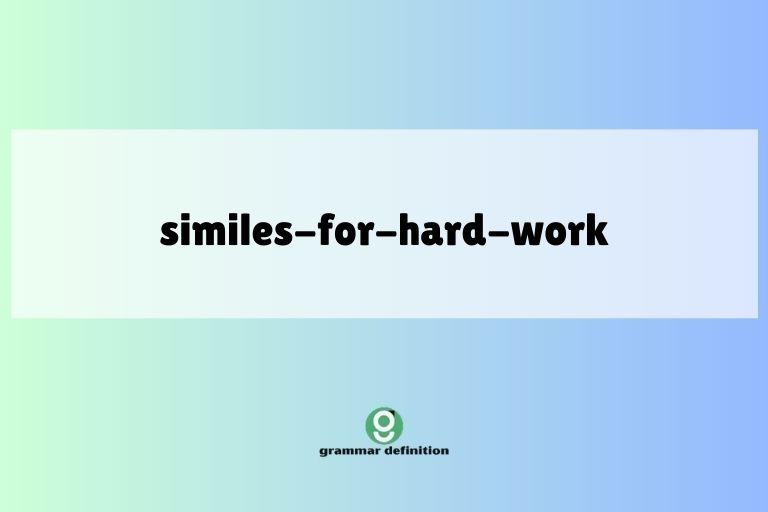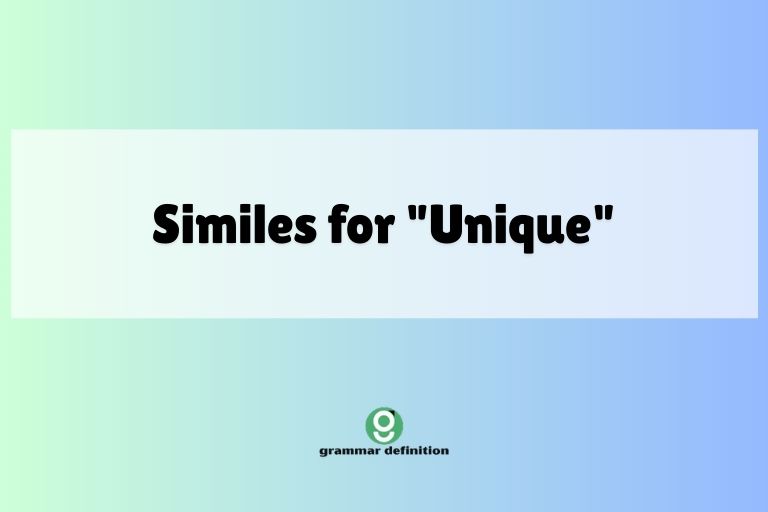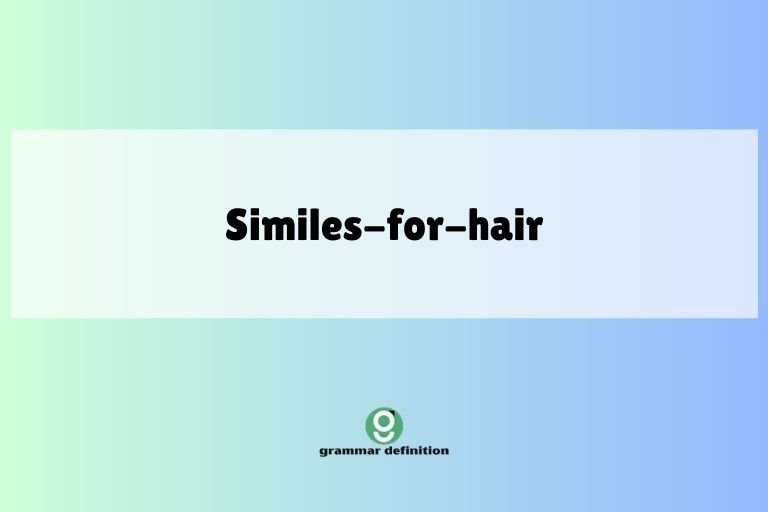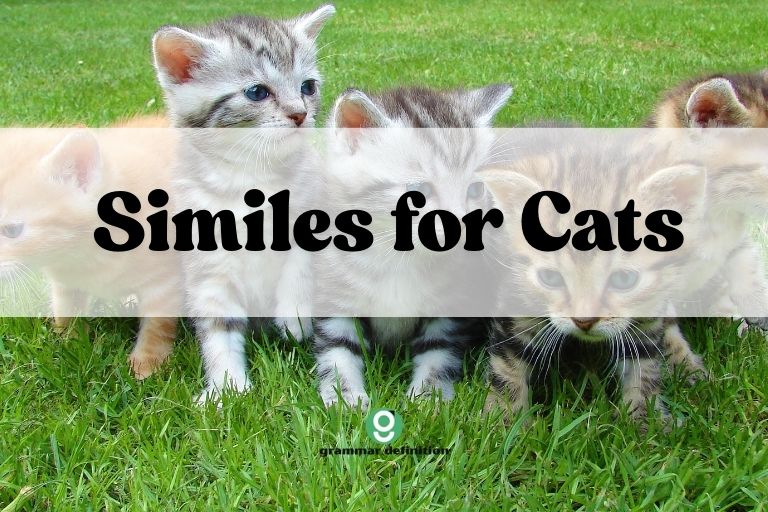Similes for Creative Writing: Enhancing Your Prose
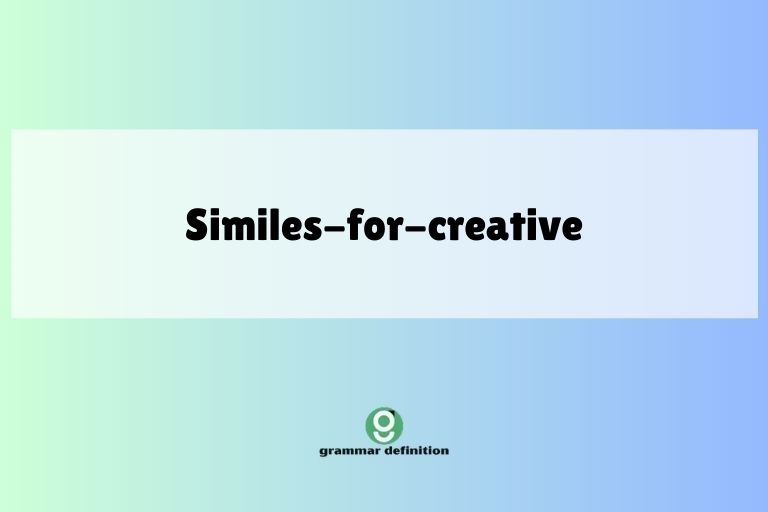
Similes are a powerful tool in any writer’s arsenal, adding depth, clarity, and vividness to prose. Understanding how to effectively use similes can transform mundane descriptions into memorable and engaging passages.
This article provides a comprehensive guide to similes, covering their definition, structure, types, usage rules, common mistakes, and practice exercises. Whether you’re a seasoned writer or just starting out, mastering similes will undoubtedly elevate your creative writing.
Table of Contents
- Introduction
- Definition of Simile
- Structural Breakdown of Similes
- Types of Similes
- Examples of Similes
- Usage Rules for Similes
- Common Mistakes with Similes
- Practice Exercises
- Advanced Topics in Similes
- Frequently Asked Questions (FAQ)
- Conclusion
Definition of Simile
A simile is a figure of speech that directly compares two different things using the words “like” or “as.” Its purpose is to create a vivid image or convey a deeper meaning by associating the qualities of one thing with another. Similes enhance descriptive writing by making it more relatable and engaging for the reader.
Similes are often confused with metaphors, another type of figurative language. While both compare two unrelated things, a simile makes an explicit comparison using “like” or “as,” whereas a metaphor implies the comparison without using these words. For instance, “He is like a lion” is a simile, while “He is a lion” is a metaphor.
Understanding the function and context of similes is crucial for effective writing. They are used to clarify, emphasize, or add stylistic flair to descriptions.
By choosing the right simile, writers can evoke specific emotions, create strong imagery, and make their writing more memorable.
Classification of Similes
Similes can be classified based on the type of comparison they make. They can describe appearance, behavior, emotion, or any other attribute.
The key is that the comparison is clear and contributes to the overall effect of the writing.
Function of Similes
The primary function of a simile is to enhance understanding and create vivid imagery. It helps the reader connect with the subject matter on a more personal level by relating it to something familiar.
Similes can also add emotional depth and stylistic flair to writing.
Contexts for Using Similes
Similes are appropriate in various writing contexts, including descriptive passages, character development, and persuasive arguments. They are particularly useful in creative writing, where the goal is to engage the reader’s imagination.
However, they should be used judiciously to avoid overuse, which can weaken their impact.
Structural Breakdown of Similes
The basic structure of a simile involves three main components: the subject, the comparison word (“like” or “as”), and the object of comparison. Understanding this structure is essential for creating effective and grammatically correct similes.
The subject is the thing being described. The comparison word connects the subject to the object of comparison.
The object of comparison is the thing to which the subject is being compared. Together, these components form a complete simile that conveys a specific meaning.
The order of these components can sometimes be varied for stylistic effect, but the core structure remains the same. For example, instead of saying “The sky is like a blue canvas,” you could say “Like a blue canvas, the sky stretched out before us.” However, clarity should always be prioritized over stylistic variation.
Let’s break down an example: “Her smile was as bright as the sun.” Here, “her smile” is the subject, “as” is the comparison word, and “the sun” is the object of comparison. This simile conveys the idea that her smile was radiant and cheerful.
Common Simile Patterns
Several common patterns are used in constructing similes. These patterns provide a framework for creating effective comparisons.
Some of the most common patterns include:
- Subject + is + like + object
- Subject + is + as + adjective + as + object
- Subject + verbs + like + object
Grammatical Rules for Similes
When constructing similes, it’s important to follow basic grammatical rules to ensure clarity and correctness. The subject and object of comparison should be grammatically parallel.
This means that they should be in the same form (e.g., both nouns or both clauses).
Additionally, the comparison word (“like” or “as”) should be used correctly. “Like” is typically used to compare nouns or pronouns, while “as” is used to compare clauses or phrases.
However, “as” can also be used with adjectives, as in “as bright as the sun.”
Types of Similes
Similes can be categorized based on the type of comparison they make. Understanding these categories can help writers choose the most effective simile for their intended purpose.
Descriptive Similes
Descriptive similes are used to describe the physical appearance or characteristics of something. They often appeal to the senses, creating vivid images in the reader’s mind.
For example, “The snow was like a white blanket” is a descriptive simile that evokes a sense of softness and tranquility.
Behavioral Similes
Behavioral similes compare the actions or behaviors of two different things. They can be used to illustrate a character’s personality or to describe a particular event.
For example, “He ate like a pig” is a behavioral simile that suggests he ate greedily and without manners.
Emotional Similes
Emotional similes are used to convey feelings or emotions by comparing them to something tangible or relatable. They can add depth and nuance to emotional descriptions.
For example, “Her heart was like a stone” is an emotional simile that suggests she was feeling cold and unfeeling.
Exaggerated Similes
Exaggerated similes, also known as hyperbole, are used to emphasize a point by making an exaggerated comparison. They are often used for humorous or dramatic effect.
For example, “I’m so hungry I could eat a horse” is an exaggerated simile that conveys extreme hunger.
Examples of Similes
To further illustrate the use of similes, here are several examples organized by category. These examples demonstrate the versatility and effectiveness of similes in enhancing descriptive writing.
Descriptive Similes Examples
The following table provides examples of descriptive similes, showcasing how they can be used to paint vivid pictures with words.
| Simile | Explanation |
|---|---|
| The lake was as smooth as glass. | Describes the lake’s surface as perfectly still and reflective. |
| Her skin was like porcelain. | Describes her skin as delicate, smooth, and pale. |
| The stars were like diamonds in the sky. | Describes the stars as bright, sparkling, and precious. |
| The fog was like a thick blanket. | Describes the fog as dense, heavy, and enveloping. |
| His voice was as smooth as velvet. | Describes his voice as soft, rich, and pleasant to listen to. |
| The desert was like a furnace. | Describes the desert as extremely hot and arid. |
| Her eyes were like emeralds. | Describes her eyes as green, bright, and precious. |
| The snow was like powdered sugar. | Describes the snow as light, fluffy, and white. |
| The moon was like a silver coin. | Describes the moon as round, bright, and metallic. |
| The clouds were like cotton candy. | Describes the clouds as light, fluffy, and sweet-looking. |
| The rain fell like tears. | Describes the rain as sorrowful and continuous. |
| The grass was as green as an emerald. | Describes the grass as vibrant and lush. |
| The silence was like a heavy curtain. | Describes the silence as oppressive and isolating. |
| The wind was like an icy knife. | Describes the wind as sharp, cold, and piercing. |
| The city was like a concrete jungle. | Describes the city as harsh, crowded, and impersonal. |
| The sand was as hot as fire. | Describes the sand as extremely hot and burning. |
| Her hair was like spun gold. | Describes her hair as fine, shiny, and valuable. |
| The night was as black as ink. | Describes the night as dark, impenetrable, and mysterious. |
| The flowers were like a rainbow. | Describes the flowers as colorful, diverse, and beautiful. |
| The ice was like a mirror. | Describes the ice as smooth, reflective, and clear. |
| The sun shone like a spotlight. | Describes the sun as intense and focused. |
| The mountains stood like giants. | Describes the mountains as massive and imposing. |
| The stream flowed like liquid silver. | Describes the stream as smooth, shiny, and precious. |
| His eyes were as blue as the ocean. | Describes his eyes as deep, vast, and serene. |
Behavioral Similes Examples
The following table provides examples of behavioral similes, showcasing how they can be used to illustrate actions and behaviors.
| Simile | Explanation |
|---|---|
| He ran like the wind. | Describes him running very fast. |
| She slept like a log. | Describes her sleeping soundly and deeply. |
| They fought like cats and dogs. | Describes them arguing and fighting frequently. |
| He ate like a bird. | Describes him eating very little. |
| She sang like an angel. | Describes her singing beautifully and flawlessly. |
| He worked like a beaver. | Describes him working diligently and tirelessly. |
| She danced like a dream. | Describes her dancing gracefully and effortlessly. |
| They gossiped like old hens. | Describes them gossiping frequently and enthusiastically. |
| He roared like a lion. | Describes him speaking loudly and fiercely. |
| She moved like a shadow. | Describes her moving silently and stealthily. |
| He swims like a fish. | Describes him swimming naturally and effortlessly. |
| She cried like a baby. | Describes her crying loudly and uncontrollably. |
| They argued like lawyers. | Describes them arguing skillfully and persuasively. |
| He acted like a fool. | Describes him behaving foolishly and irrationally. |
| She followed like a sheep. | Describes her following blindly and unquestioningly. |
| He studied like a scholar. | Describes him studying diligently and thoroughly. |
| She worried like a mother hen. | Describes her worrying excessively and protectively. |
| They chattered like monkeys. | Describes them chattering noisily and incessantly. |
| He grumbled like a bear. | Describes him grumbling irritably and constantly. |
| She listened like a hawk. | Describes her listening attentively and intently. |
| He planned like a general. | Describes him planning strategically and thoroughly. |
| She negotiated like a diplomat. | Describes her negotiating skillfully and tactfully. |
| They celebrated like champions. | Describes them celebrating enthusiastically and triumphantly. |
| He persevered like a soldier. | Describes him persevering resolutely and bravely. |
Emotional Similes Examples
The following table provides examples of emotional similes, showcasing how they can be used to convey feelings and emotions.
| Simile | Explanation |
|---|---|
| His heart was as cold as ice. | Describes him as unfeeling and detached. |
| She felt like a fish out of water. | Describes her feeling uncomfortable and out of place. |
| He was as happy as a clam. | Describes him as very content and carefree. |
| She was as nervous as a long-tailed cat in a room full of rocking chairs. | Describes her as extremely anxious and uneasy. |
| He felt like a million dollars. | Describes him as feeling great and confident. |
| She was as light as a feather. | Describes her feeling free and unburdened. |
| He was as mad as a hornet. | Describes him as very angry and agitated. |
| She felt like she was walking on air. | Describes her feeling elated and joyful. |
| He was as stubborn as a mule. | Describes him as very obstinate and unyielding. |
| She felt like she had been hit by a truck. | Describes her feeling exhausted and overwhelmed. |
| He was as quiet as a mouse. | Describes him as shy and reserved. |
| She felt like she was in a dream. | Describes her feeling surreal and detached. |
| He was as brave as a lion. | Describes him as courageous and fearless. |
| She felt like she was drowning. | Describes her feeling overwhelmed and helpless. |
| He was as sly as a fox. | Describes him as cunning and deceitful. |
| She felt like she was reborn. | Describes her feeling renewed and invigorated. |
| He was as gentle as a lamb. | Describes him as kind and compassionate. |
| She felt like she was losing her mind. | Describes her feeling confused and disoriented. |
| He was as proud as a peacock. | Describes him as vain and arrogant. |
| She felt like she was floating. | Describes her feeling weightless and serene. |
| He was as restless as the sea. | Describes him as uneasy and constantly moving. |
| She felt like she was home. | Describes her feeling comfortable and safe. |
| He was as sharp as a tack. | Describes him as intelligent and quick-witted. |
| She felt like she was invisible. | Describes her feeling unnoticed and insignificant. |
Usage Rules for Similes
Using similes effectively requires adherence to certain rules and guidelines. These rules ensure that similes are clear, meaningful, and contribute to the overall quality of the writing.
First, ensure that the comparison is logical and relevant. The two things being compared should share a common attribute or quality.
Avoid making comparisons that are too abstract or obscure, as they may confuse the reader.
Second, use similes sparingly. Overusing similes can make your writing sound cliché and repetitive.
Choose similes that are fresh and original, and use them only when they add significant value to the description.
Third, consider the context and audience. The effectiveness of a simile depends on the reader’s understanding and familiarity with the objects being compared.
Choose similes that are appropriate for your target audience and the overall tone of your writing.
Exceptions to the Rules
While the above rules provide a general framework for using similes, there are exceptions. For example, in certain types of writing, such as poetry or experimental fiction, writers may intentionally break these rules to create a specific effect.
Additionally, some similes have become so common that they are considered clichés. While it’s generally best to avoid clichés, they can be used effectively in certain contexts, such as when writing dialogue for a character who is unsophisticated or unoriginal.
Common Mistakes with Similes
Several common mistakes can undermine the effectiveness of similes. Being aware of these mistakes can help writers avoid them and use similes more effectively.
One common mistake is using clichés. Clichés are overused similes that have lost their impact.
Examples include “as blind as a bat” and “as strong as an ox.” While these similes may be familiar, they lack originality and can make your writing sound uninspired.
Another common mistake is making illogical comparisons. The two things being compared should share a clear and relevant attribute.
Avoid making comparisons that are too far-fetched or nonsensical.
A third common mistake is overusing similes. Too many similes can make your writing sound cluttered and repetitive.
Use similes sparingly and only when they add significant value to the description.
| Incorrect | Correct | Explanation |
|---|---|---|
| He ran like a turtle. | He ran like the wind. | The comparison should be appropriate; turtles are slow, not fast. |
| She was as unique as everyone else. | She was as unique as a snowflake. | The comparison should highlight individuality. |
| The food tasted like food. | The food tasted like sunshine and summer. | The comparison should be descriptive and evocative. |
| He was as boring as a rock. | He was as boring as watching paint dry. | The comparison should be relatable and engaging. |
| She sang like a singer. | She sang like a nightingale. | The comparison should be specific and descriptive. |
| The movie was as good as a movie. | The movie was as good as a dream. | The comparison should enhance the description. |
| He was as ordinary as a person. | He was as ordinary as a grain of sand. | The comparison should be more vivid. |
| She felt like a feeling. | She felt like a wilted flower. | The comparison should be concrete and descriptive. |
| The car was as fast as a car. | The car was as fast as a rocket. | The comparison should be striking and memorable. |
| He was as tall as a tall person. | He was as tall as a skyscraper. | The comparison should be exaggerated for effect. |
Practice Exercises
To reinforce your understanding of similes, here are several practice exercises. These exercises will help you identify and create effective similes in your own writing.
Exercise 1: Identifying Similes
Identify the similes in the following sentences.
| Question | Answer |
|---|---|
| 1. The baby’s skin was as soft as silk. | as soft as silk |
| 2. He roared like a lion when he was angry. | like a lion |
| 3. She was a rock in a hard place. | (This is a metaphor, not a simile) |
| 4. The stars twinkled like diamonds in the night sky. | like diamonds |
| 5. The old house stood silent, like a forgotten memory. | like a forgotten memory |
| 6. The detective was as sharp as a razor. | as sharp as a razor |
| 7. Time is money. | (This is a metaphor, not a simile) |
| 8. The ballerina moved as gracefully as a swan. | as gracefully as a swan |
| 9. The politician spoke with the charisma of a leader. | (No simile present) |
| 10. Her smile shone as brightly as the morning sun. | as brightly as the morning sun |
Exercise 2: Completing Similes
Complete the following similes with appropriate objects of comparison.
| Question | Answer |
|---|---|
| 1. The coffee was as hot as __________. | lava |
| 2. He was as busy as __________. | a bee |
| 3. The music was like __________ to my ears. | honey |
| 4. She was as quiet as __________. | a mouse |
| 5. The exam was as easy as __________. | pie |
| 6. The snow fell like __________. | feathers |
| 7. The old car ran like __________. | a dream |
| 8. He was as nervous as __________. | a cat on a hot tin roof |
| 9. The cake tasted like __________. | heaven |
| 10. The crowd roared like __________. | thunder |
Exercise 3: Creating Similes
Create your own similes to describe the following subjects.
| Subject | Possible Simile |
|---|---|
| 1. A thunderstorm | The thunderstorm was like an angry giant, roaring and shaking the earth. |
| 2. A crowded city street | The city street was like a river of people, constantly flowing and changing. |
| 3. A peaceful forest | The forest was as peaceful as a sleeping baby, quiet and serene. |
| 4. A difficult challenge | The challenge was like climbing a mountain, steep and arduous. |
| 5. A close friendship | Our friendship is like a warm fire, comforting and supportive. |
| 6. A lost opportunity | The lost opportunity was like a fading star, gone too soon. |
| 7. A new beginning | The new beginning was as bright as the morning sun, full of promise. |
| 8. A broken heart | Her broken heart felt like shattered glass, sharp and painful. |
| 9. A vivid dream | The dream was like a surreal painting, filled with strange images and emotions. |
| 10. A lasting memory | The memory was as clear as a photograph, etched in my mind forever. |
Advanced Topics in Similes
For advanced learners, exploring more complex aspects of similes can further enhance their writing skills. These topics include extended similes, mixed similes, and the use of similes in different genres.
Extended similes involve developing a simile over several sentences or paragraphs, elaborating on the comparison and exploring its various facets. This technique can create a more immersive and impactful image in the reader’s mind.
Mixed similes combine elements of different similes to create a more complex and nuanced comparison. While this technique can be effective, it should be used carefully to avoid confusion or contradiction.
The use of similes can vary depending on the genre of writing. For example, similes in poetry may be more metaphorical and evocative, while similes in scientific writing may be more literal and precise.
Understanding these genre-specific conventions can help writers use similes more effectively in different contexts.
Frequently Asked Questions (FAQ)
Here are some frequently asked questions about similes, along with detailed answers to address common concerns and misconceptions.
-
Q: What is the difference between a simile and a metaphor?
A: A simile is a comparison using “like” or “as,” while a metaphor implies a comparison without using those words. For example, “He is like a lion” (simile) vs. “He is a lion” (metaphor).
-
Q: Can a simile be a cliché?
A: Yes, if a simile is overused and unoriginal, it becomes a cliché. It’s best to avoid clichés and use fresh, creative comparisons.
-
Q: How can I make my similes more effective?
A: Choose comparisons that are logical, relevant, and vivid. Use similes sparingly and consider the context and audience.
-
Q: Is it okay to use similes in formal writing?
A: Yes, but use them judiciously. Similes can add clarity and emphasis, but avoid using too many in formal contexts.
-
Q: What are some examples of bad similes?
A: Bad similes are often illogical, cliché, or nonsensical. For example, “He ran like a refrigerator” or “She was as unique as everyone else.”
-
Q: How do I avoid overusing similes in my writing?
A: Use similes only when they add significant value to the description. Vary your sentence structure and use other descriptive techniques, such as metaphors and imagery.
-
Q: Can I use similes in poetry?
A: Absolutely! Similes are a powerful tool in poetry for creating vivid images and conveying emotions. Experiment with different types of similes to enhance your poems.
-
Q: What role do similes play in storytelling?
A: Similes enhance storytelling by making descriptions more vivid and engaging. They help readers connect with the characters, settings, and events on a more personal level.
Conclusion
Mastering similes is an essential skill for any writer looking to enhance their creative writing. By understanding the definition, structure, types, and usage rules of similes, you can effectively incorporate them into your prose.
Remember to avoid clichés, make logical comparisons, and use similes sparingly to maximize their impact.
Practice identifying, completing, and creating similes to reinforce your understanding and develop your writing skills. As you become more comfortable with similes, experiment with advanced techniques such as extended similes and mixed similes.
With consistent practice, you can elevate your writing and create more vivid and engaging descriptions.
Ultimately, effective use of similes can transform ordinary writing into extraordinary prose, captivating readers and leaving a lasting impression. Embrace the power of similes and watch your creative writing flourish.

